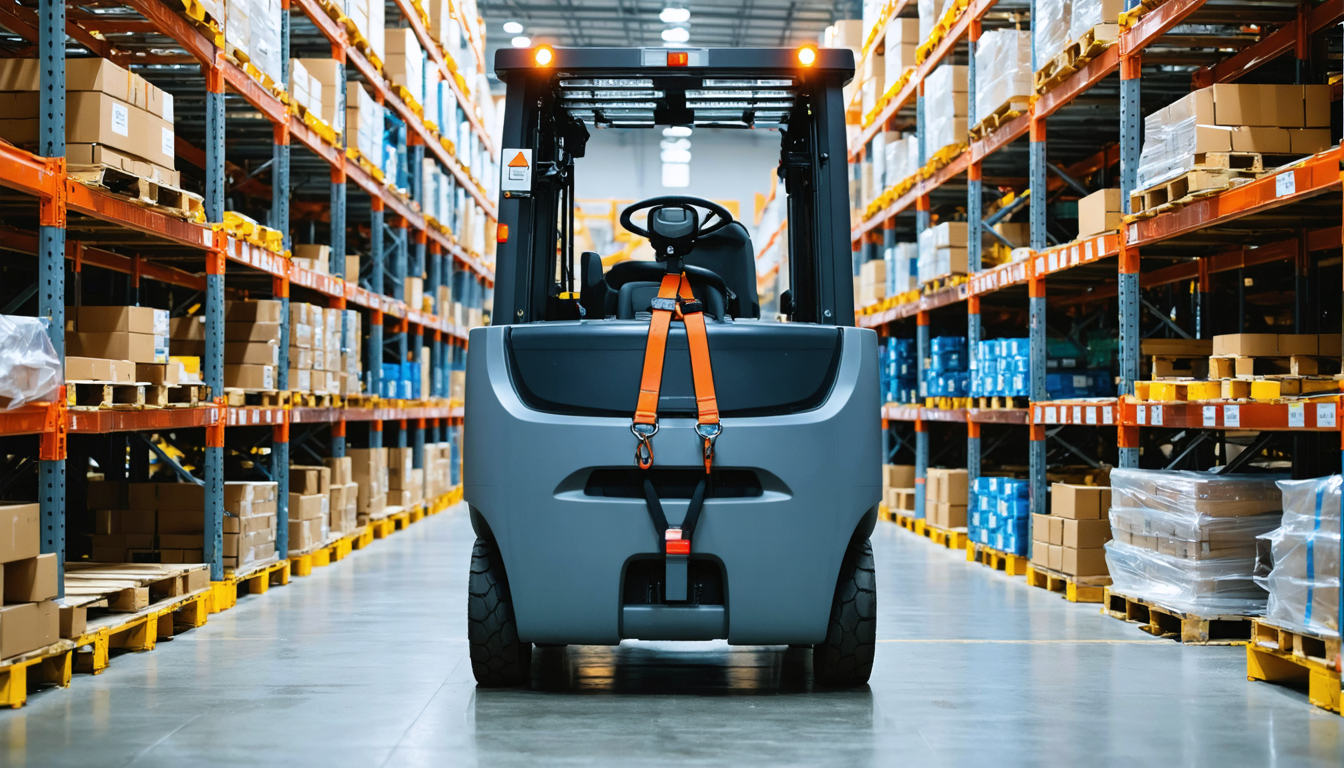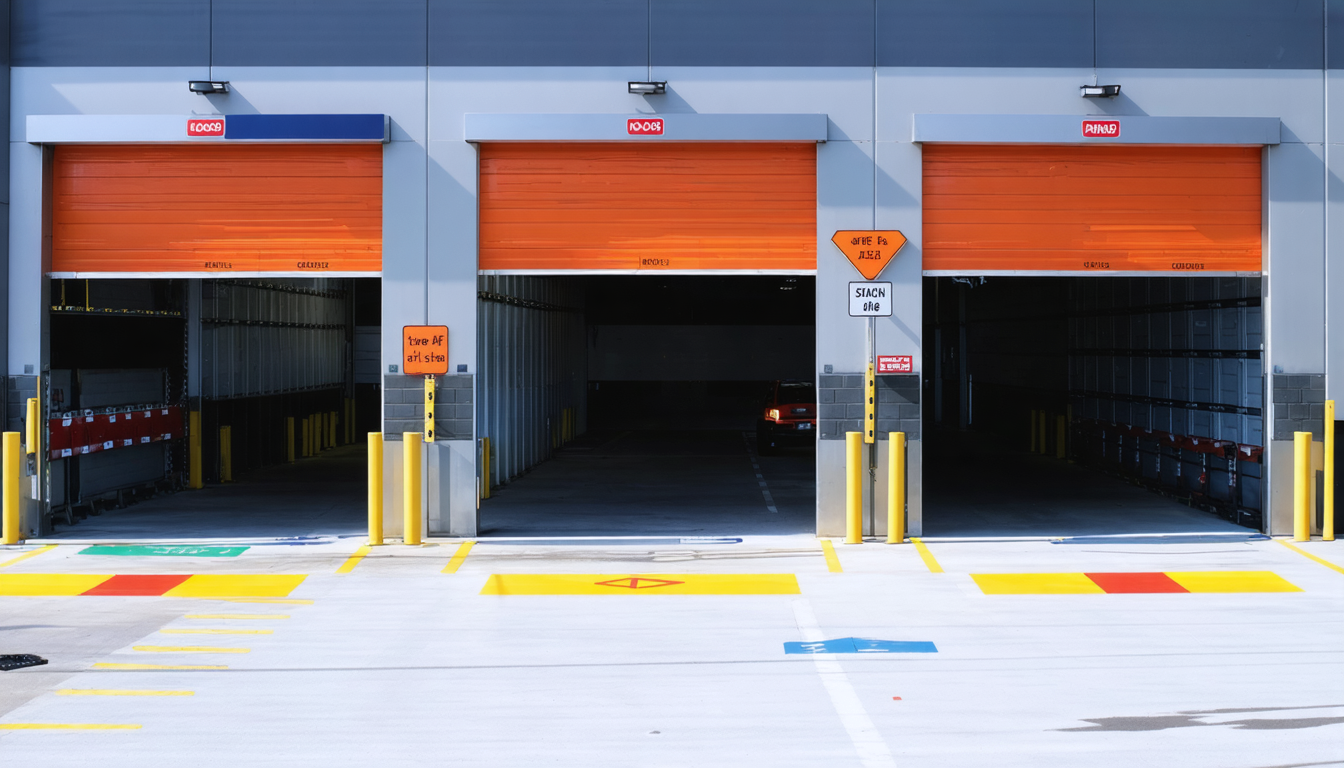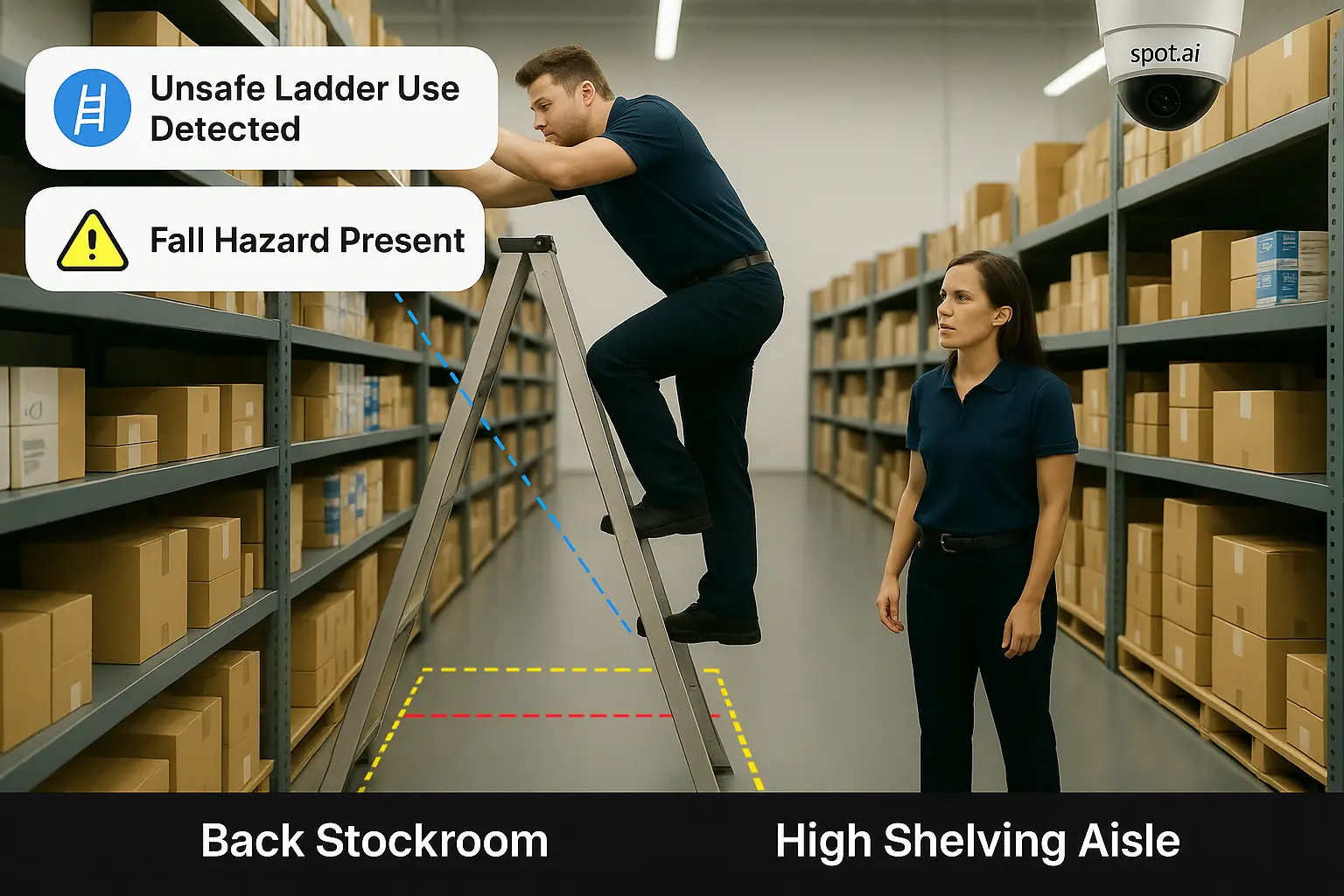Each year, falls from elevation rack up billions in direct costs for retailers and disrupt operations in ways that go far beyond the injury itself. In fact, these incidents accounted for $5.78 billion in direct costs in 2022 alone, making them one of the top drivers of disabling workplace injuries across all industries (Source: Liberty Mutual Workplace Safety Index, 2025). With retail warehouses, stockrooms, and elevated work areas all in the spotlight, the risks are real—and so are the consequences for budgets and compliance.
But here’s the good news: most falls from elevation can be prevented. By combining strong safety protocols with next-generation technology—like AI-powered video intelligence—retailers are moving from reacting after-the-fact to proactively stopping incidents before they start. This guide breaks down the true costs, root causes, and provides a clear framework for moving from a reactive to a proactive safety model using modern technology.
Why Falls from Elevation Are a Costly Threat for Retailers
Falls to from heights are a unique challenge in retail, especially in environments with elevated storage, rolling ladders, mezzanines, and busy loading docks. While overall injury rates in retail have declined by 40% over the last 25 years, the severity and cost of injuries—especially from falls—keep climbing. Workers’ compensation benefits for serious injuries have risen by 30% over the same period, reflecting the greater impact of these incidents (Source: Liberty Mutual, 2025).
The Top 5 Causes of Falls from Elevation in Retail—and Proactive Prevention
Understanding why these incidents happen is the first step to stopping them. Here are the five leading causes—plus practical prevention tips and how AI video intelligence can take your safety program to the next level.
1. Unsafe Ladder Practices
The Hazard:
A stock associate grabs a rolling ladder to restock high shelves during a busy morning. Distracted by a customer’s question, he rushes, skips checking the ladder’s stability, and climbs while holding merchandise. The ladder wobbles, and he falls, suffering a hip injury. OSHA data shows ladders (step ladders, movable ladders, etc.) are the leading source of falls from elevation retail.
Traditional Prevention:
Routine ladder inspections for wear and damage
Training on three-point contact and safe use
Signage and reminders to select the right ladder for the job
How AI Amplifies Prevention:
AI video analytics can automatically detect when someone is using a ladder unsafely or outside of designated times, flagging incidents like sudden falls with “possible fall” events. Reviewing these alerts helps managers identify patterns—such as improper ladder placement or rushing—and retrain teams proactively. Real-time detection means help arrives quickly, and root cause analysis gets easier.
2. Falls From Mezzanines, Platforms, or Overhead Storage
The Hazard:
A team lead is retrieving seasonal inventory from a mezzanine. She leans over a missing guardrail to grab a box, loses her balance, and falls to the concrete below. Inadequate barriers or damaged guardrails are a common root cause, as highlighted in recent OSHA investigations.
Traditional Prevention:
Permanent guardrails and barriers on all elevated areas
Weekly inspections of mezzanines and platforms
Maintenance logs to repair damaged rails quickly
How AI Amplifies Prevention:
AI-powered video systems can monitor for “person enters no-go zones”—alerting teams if someone enters an unprotected or restricted elevated area. This enables supervisors to intervene before a risky action becomes an incident. Video analytics also help document compliance with 29 CFR 1910.23, which mandates guardrails for platforms 4 feet or higher (Source: OSHA, 2025).
3. Falls From Powered Industrial Trucks (Forklifts, Order Pickers)

The Hazard:
During a busy shift, an associate rides an order picker to retrieve stock from a high bay. Failing to secure the harness, he leans over the side for a hard-to-reach item. The sudden stop of the lift causes him to lose balance and fall. OSHA data confirms that falls from powered industrial trucks are a significant contributor to retail fall injuries.
Traditional Prevention:
Operator certification and re-certification for all powered trucks
Mandatory use of fall protection gear
Visual safety checks before use
How AI Amplifies Prevention:
AI analytics can detect “possible fall” events from lifts and order pickers in real time, enabling quick first response and detailed review of the incident. Over time, the system surfaces patterns—like recurring non-compliance with harness use—helping safety teams focus retraining where it matters most.
4. Falls From Loading Docks, Ramps, or Stairs

The Hazard:
A delivery driver is rushing to unload pallets on a loading dock during peak hours. Poor lighting and a cluttered dock edge cause him to misstep and fall to the pavement below, injuring his ankle and leg. Loading docks and ramps are recurring sources of severe retail falls.
Traditional Prevention:
Good lighting and clear marking of dock edges
Housekeeping protocols to keep docks and ramps free of clutter
Regular safety reminders and toolbox talks
How AI Amplifies Prevention:
Video intelligence can continuously monitor for “possible fall” and “running” events near loading docks and ramps—highlighting unsafe behaviors before they become incidents. Over time, analytics reveal high-risk locations and times, allowing teams to adjust workflows or increase monitoring during peak risk.
5. Unsafe Shortcuts and Rushing
The Hazard:
Pressed for time, an employee skips proper procedures to quickly hang a promotional banner from a tire rack. Without supervision or instructions, he climbs onto unstable shelving and falls over 15 feet (a scenario drawn from recent OSHA investigations).
Traditional Prevention:
Supervisor oversight and clear work instructions
Training employees to recognize and avoid shortcuts
Encouraging reporting of unsafe conditions without fear
How AI Amplifies Prevention:
AI video systems can flag “running” and “possible fall” events—both strong indicators of rushing or unsafe shortcuts. Reviewing these incidents helps safety leaders spot trends (like certain shifts or tasks with higher risk) and reinforce a culture of safety. Real-time alerts mean supervisors can intervene as soon as risky behavior is detected.
Integrating a Modern AI Camera System: From NVR to AI-Driven Safety Insights in Retail
Upgrading your safety technology doesn’t mean ripping and replacing your entire camera infrastructure. Modern AI video platforms are designed to bridge your existing on-premise cameras—including standard POE devices—to a secure, cloud-native dashboard. This approach eliminates bulky, maintenance-heavy NVR hardware and gives you scalable, always-available video storage.
Here’s how a modern AI camera system stacks up for retail:
Feature | Traditional NVR System | Cloud-Based AI Camera Platform |
|---|---|---|
Camera Compatibility | Requires new/specific cameras | Works with existing POE/legacy cams |
Storage | On-premise servers | Secure, scalable cloud storage |
Maintenance | Frequent, on-site | Minimal, remote updates |
User Access | Limited seats | Unlimited users, unified dashboard |
Incident Review | Manual, time-consuming | AI-powered search & instant alerts |
Actionable Insights | Passive footage only | Real-time fall, running, loitering alerts |
With this system, you don’t just record what happens—you get proactive insights. The AI layer sits on top of your video feeds, detecting “possible fall,” “running,” and “person enters no-go zone” events as they happen. This empowers safety, IT, and operations teams to respond faster, investigate incidents more efficiently, and continuously improve protocols—all without adding headcount.
Practical Tips for Retail Implementation:
Check Compatibility: Choose platforms that work with your current cameras, so you avoid unnecessary upgrades.
Prioritize Safety Goals: Ensure your system supports OSHA and company safety standards—like real-time detection of falls and access violations.
Integrate with Safety Programs: AI video should be an extension of your incident reporting, staff training, and regular safety audits.
Scale Access: Look for solutions that allow unlimited user seats, so safety isn’t siloed to a few managers.
By moving from a traditional NVR to a smart, cloud-based AI platform, you turn your video system from a passive cost center into a proactive safety engine.
Transform Retail Safety—Book a Safety Consultation
Every fall from elevation is a chance to get better, not just respond. By integrating modern AI-powered video analytics with your existing protocols, you can reduce risk, speed up investigations, and support every team member’s safety on the sales floor and in the backroom.
Ready to see how video intelligence can help prevent the next incident—and make your whole safety program more effective? Book a safety consultation with Spot AI’s experts and get practical, actionable guidance for your stores and warehouses. Book a safety consultation
Frequently asked questions
What are the most common causes of falls from elevation in retail environments?
The primary causes are unsafe ladder practices, missing or damaged guardrails on elevated platforms, falls from powered industrial trucks, falls from loading docks or ramps, and unsafe shortcuts or rushing (Source: OSHA, 2025).
How can AI-powered video analytics help prevent fall accidents in retail?
AI video analytics automatically detect possible falls, running, and unauthorized entry into restricted zones in real time. This allows safety teams to intervene immediately and review incidents efficiently, supporting proactive prevention and training.
Is special camera hardware required to use AI video analytics for safety?
No. Modern AI video platforms are designed to work with most existing on-premise and POE cameras. The system bridges your current infrastructure to a cloud-native dashboard, so there’s no need for a full hardware upgrade.
How can retailers ensure compliance with OSHA’s fall protection standards?
Retailers should maintain guardrails on all platforms over 4 feet high (OSHA 29 CFR 1910.23), ensure proper ladder use, and require fall protection equipment for elevated work. Regular training and AI-powered monitoring help enforce compliance and identify gaps before they lead to incidents (Source: OSHA, 2025).
What are the key features to look for when evaluating AI camera systems for retail safety?
Look for compatibility with your current cameras, cloud-based storage, unlimited user access, and AI capabilities that can detect falls, running, and no-go zone violations. Integration with incident reporting and easy video search are also valuable.
How does AI video analytics support incident investigation?
AI-powered platforms flag incidents like possible falls or unsafe behaviors, making it quick to find and review relevant footage. This streamlines root cause analysis, supports compliance documentation, and reduces investigation time.
How can safety technology help reduce stress for safety managers?
AI-driven analytics automate the detection of hazards and incidents, freeing safety managers from constant manual monitoring. This allows them to focus on proactive planning, training, and team support instead of reacting to every event.
About the author
Joshua Foster
IT Systems Engineer, Spot AI
Joshua Foster is an IT Systems Engineer at Spot AI, where he focuses on designing and securing scalable enterprise networks, managing cloud-integrated infrastructure, and automating system workflows to enhance operational efficiency. He is passionate about cross-functional collaboration and takes pride in delivering robust technical solutions that empower both the Spot AI team and its customers.






















.png)
.png)
.png)